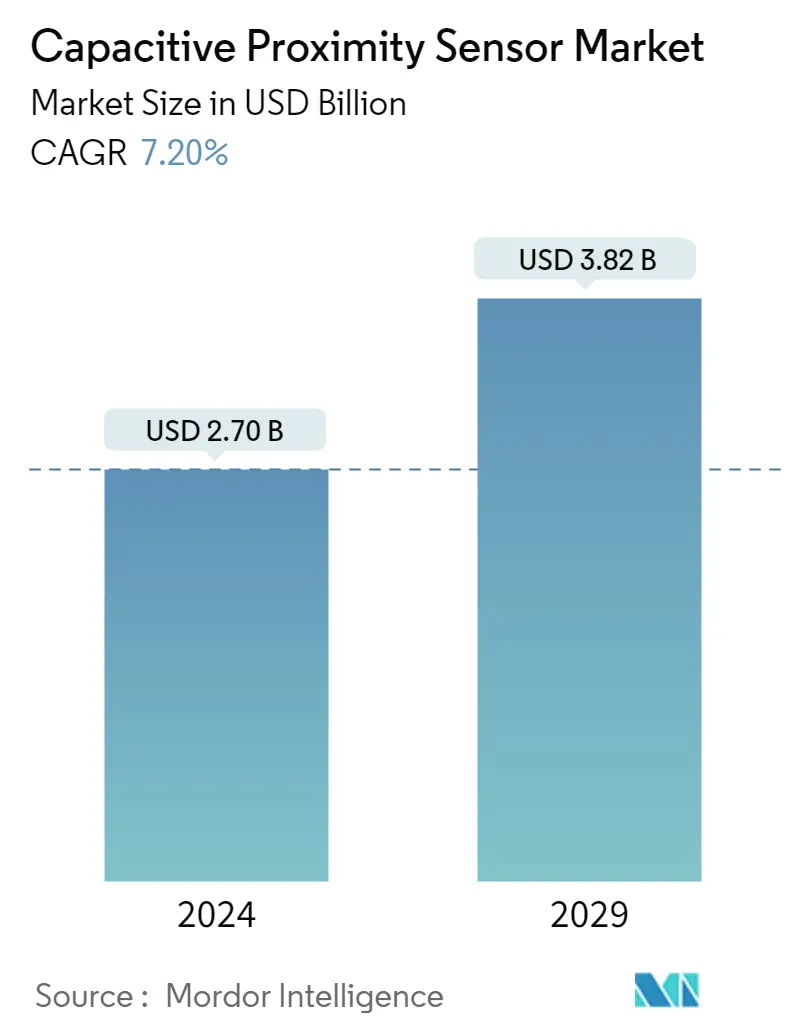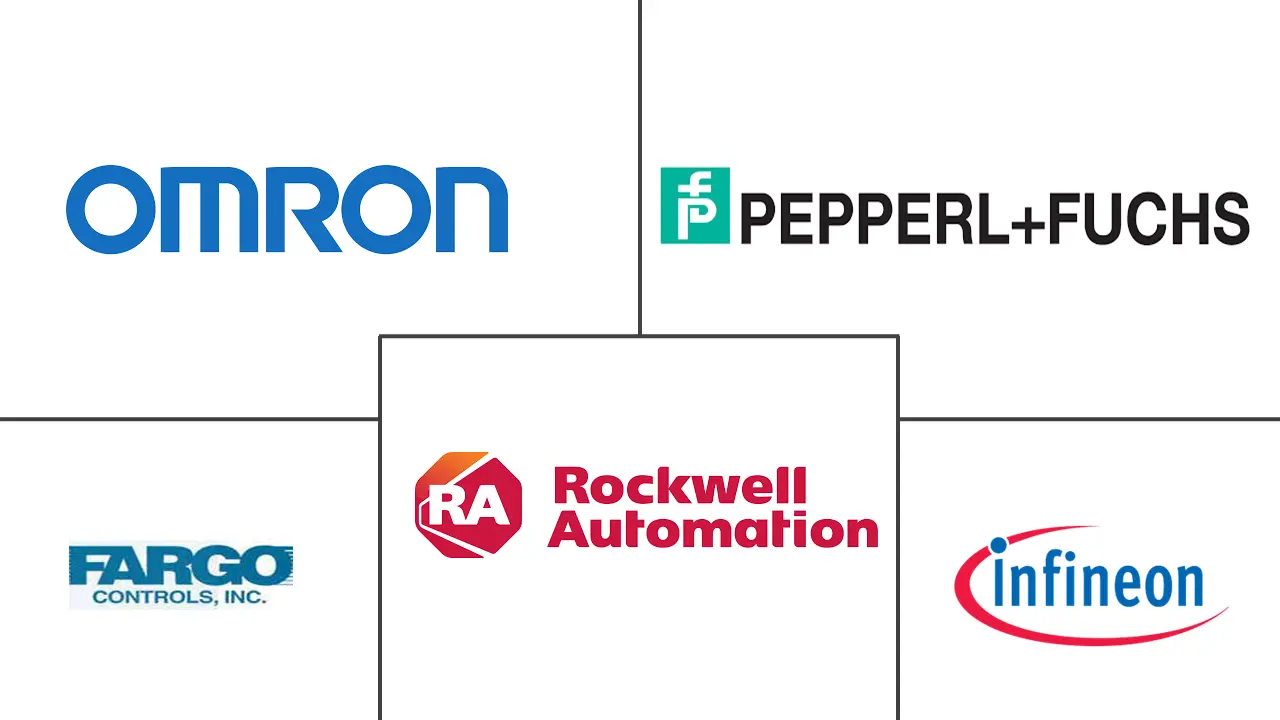Market Size of Capacitive Proximity Sensor Industry

| Study Period | 2019 - 2029 |
| Market Size (2024) | USD 2.70 Billion |
| Market Size (2029) | USD 3.82 Billion |
| CAGR (2024 - 2029) | 7.20 % |
| Fastest Growing Market | Asia Pacific |
| Largest Market | Asia Pacific |
Major Players
*Disclaimer: Major Players sorted in no particular order |
Capacitive Proximity Sensors Market Analysis
The Capacitive Proximity Sensor Market size is estimated at USD 2.70 billion in 2024, and is expected to reach USD 3.82 billion by 2029, growing at a CAGR of 7.20% during the forecast period (2024-2029).
A capacitive proximity sensor is a sensing device designed to detect metallic and non-metallic targets. It may detect lightweight or small objects that mechanical limit switches cannot see. They use dielectric principles of capacitance to establish a sensing field near the sensor's face, creating a detecting zone. These sensors operate by recording a change in the capacitance read by the sensor.
- The amount of capacitance varies depending on the size and distance of the sensing object. An ordinary capacitive proximity sensor is similar to a capacitor with two parallel plates, where the capacity of the two plates is detected. The sensor consists of a high-frequency oscillator and an amplifier. When an object approaches the sensor’s detection surface, the capacitance of the loop varies, causing the high-frequency oscillator to vibrate. Amplifiers transform the oscillation and stop states into electrical signals, which are then turned into binary switching signals.
- Capacitive proximity sensors have a wide sensitivity band, enabling them to detect objects through non-metallic walls. They are known for their long operational lifespan, making them reliable for various applications. These sensors are highly sensitive and can accurately detect very small deflections, making them suitable for various applications like motion, displacement, chemical composition, electric field, pressure, acceleration, fluid level, and fluid composition.
- The growth in manufacturing facilities and production plants is a major driver for the capacitive proximity sensors market. These sensors can simplify and decrease the time consumption in production functions while enhancing the dependability, accuracy, and involvement of a low task force.
- Moreover, while capacitive proximity sensors offer numerous advantages, they have some limitations in sensing capabilities that can hinder their growth. Capacitive proximity sensors are sensitive to the dielectric properties of materials. While they can detect a wide range of materials, including metals, liquids, and plastics, they struggle with certain materials that have low dielectric constants or are highly conductive.
Capacitive Proximity Sensors Industry Segmentation
A capacitive proximity sensor is a sensing device designed to detect metallic and nonmetallic targets. It may detect lightweight or small objects that mechanical limit switches cannot detect. It uses dielectric principles of capacitance to establish a sensing field in the vicinity of the sensor's face, creating a detecting zone.
The capacitive proximity sensor market is segmented by type (touch sensors, motion sensors, position sensors, and other types), end-user industry (healthcare, manufacturing, automotive, consumer electronics, food and beverage, metals and mining, aerospace and defense, and other end-user industries), and geography (North America, Europe, Asia-Pacific, Latin America, and the Middle East & Africa). The report offers the market size in value terms in USD for all the abovementioned segments.
| By Type | |
| Touch Sensors | |
| Motion Sensors | |
| Position Sensors | |
| Other Types |
| By End-user Industry | |
| Healthcare | |
| Manufacturing | |
| Automotive | |
| Consumer Electronics | |
| Food and Beverage | |
| Metals and Mining | |
| Aerospace and Defense | |
| Other End-user Industries |
| By Geography*** | |
| North America | |
| Europe | |
| Asia | |
| Australia and New Zealand | |
| Latin America | |
| Middle East and Africa |
Capacitive Proximity Sensor Market Size Summary
The capacitive proximity sensor market is poised for significant growth, driven by its increasing application across various industries. These sensors, which utilize dielectric principles to detect both metallic and non-metallic objects, are becoming essential in manufacturing and production environments due to their ability to enhance efficiency and accuracy. Their sensitivity to small deflections and ability to operate through non-metallic barriers make them ideal for a range of applications, including motion detection, fluid level monitoring, and touch-sensitive interfaces in consumer electronics. The market is experiencing a surge in demand as industries seek to automate processes and improve operational reliability, although challenges remain in their sensitivity to certain materials with low dielectric constants.
Regionally, Asia-Pacific is expected to lead the market growth, with countries like China, Japan, and South Korea investing heavily in robotics and advanced manufacturing technologies. The Chinese government's "Made in China 2025" initiative is a significant driver, aiming to bolster the country's high-tech manufacturing capabilities, including robotics, which rely on capacitive proximity sensors for precise operations. The market is characterized by fragmentation, with key players like Rockwell Automation, Omron Corporation, and Infineon Technologies actively expanding their product offerings and distribution networks. Recent technological advancements, such as Balluff's IO-Link communication sensors and ROHM's compact proximity sensors, are further propelling market potential, particularly in sectors requiring miniaturization and enhanced functionality, such as wearable devices.
Capacitive Proximity Sensor Market Size - Table of Contents
-
1. MARKET INSIGHTS
-
1.1 Market Overview
-
1.2 Industry Value Chain Analysis
-
1.3 Industry Attractiveness - Porter's Five Forces Analysis
-
1.3.1 Bargaining Power of Suppliers
-
1.3.2 Bargaining Power of Buyers
-
1.3.3 Threat of New Entrants
-
1.3.4 Threat of Substitute Products
-
1.3.5 Intensity of Competitive Rivalry
-
-
1.4 Impact of COVID-19 Aftereffects and Other Macroeconomic Factors on the Market
-
-
2. MARKET SEGMENTATION
-
2.1 By Type
-
2.1.1 Touch Sensors
-
2.1.2 Motion Sensors
-
2.1.3 Position Sensors
-
2.1.4 Other Types
-
-
2.2 By End-user Industry
-
2.2.1 Healthcare
-
2.2.2 Manufacturing
-
2.2.3 Automotive
-
2.2.4 Consumer Electronics
-
2.2.5 Food and Beverage
-
2.2.6 Metals and Mining
-
2.2.7 Aerospace and Defense
-
2.2.8 Other End-user Industries
-
-
2.3 By Geography***
-
2.3.1 North America
-
2.3.2 Europe
-
2.3.3 Asia
-
2.3.4 Australia and New Zealand
-
2.3.5 Latin America
-
2.3.6 Middle East and Africa
-
-
Capacitive Proximity Sensor Market Size FAQs
How big is the Capacitive Proximity Sensor Market?
The Capacitive Proximity Sensor Market size is expected to reach USD 2.70 billion in 2024 and grow at a CAGR of 7.20% to reach USD 3.82 billion by 2029.
What is the current Capacitive Proximity Sensor Market size?
In 2024, the Capacitive Proximity Sensor Market size is expected to reach USD 2.70 billion.

